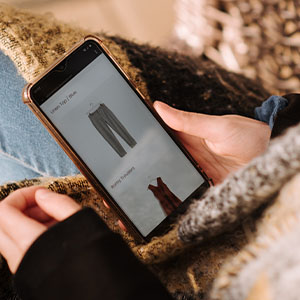


How users interact with your business's social media account
25/02/2021
Social media can be used by businesses in incredibly diverse ways; whether it's engaging with new/existing customers, promoting products/services, increasing brand exposure or in any number of other creative ways. When deciding how to get the most out of your social media endeavours and forming a strategy, businesses can often make the mistake of focussing too heavily on what they want to say, but research shows it's vitally important to first be aware of what users are there for in the first place. Putting energy into a strategy that doesn't generate engagement is not a good use of business resource, so understanding how users interact with social media content and learning from this data can provide valuable insight.
Research shows that users increasingly use social media platforms to actively find content, treating them like search engines. These searches can be motivated by a huge range of different desires, but commonly centre around an intentional hunt for more information on a topic, product, or individual/brand. These searches inevitably result in some users following website links and continuing their journeys off of the social media channel. For this reason, just as you might spend time and energy on Search Engine Optimisation (SEO) to improve the visibility of your website in 'natural' search engine results, it is also important to spend time analysing whether your content is visible in social media searches and if not, to understand why.
This month we look at six key motivations that drive social media interaction and how you can use this insight to your advantage.
Discover
 Customers already familiar with your business will likely search for you directly when they want to engage with you on social media, but increasing your business's potential to be discovered by new and potential customers will naturally widen your exposure and audience. We've loosely grouped the way users will discover your business for the first time on social media into two categories: incidental discovery and intentional discovery.
Customers already familiar with your business will likely search for you directly when they want to engage with you on social media, but increasing your business's potential to be discovered by new and potential customers will naturally widen your exposure and audience. We've loosely grouped the way users will discover your business for the first time on social media into two categories: incidental discovery and intentional discovery.
Incidental discovery can take place when users simply stumble upon your business either in their existing media feeds or when browsing and exploring new content (e.g. Instagram's Explore tab). Whilst the user isn't directly looking for either your business or your products or services, the social media platform may expose your business to them anyway. Common examples of this include paid advertising, where you can define the audience you're looking to reach and your advert will appear in a user's feed, or alternatively by your channel or posts being recommended to users by the platform's algorithms which look at users' interests and browsing history. Improving your business's incidental discoverability can be addressed in a targetted way (such as the example of paid advertising), or by ensuring your posts and channel are adequately optimised towards the audiences you're looking for. This should involve including the right keywords and hashtags in your post descriptions, checking your frequency of posting and the amount you actively engage and respond to other users.
Intentional discovery occurs when a user is actively looking for something related to your business and discovers you during their journey. An example of this could be if your business sold furniture and a user came upon your posts while looking for inspiration for a new sofa for example. In this scenario their journey might begin with a search for relevant hashtags, such as #sofa or #livingroominspo. As well as browsing through posts however, users are often interested in following new brands/channels that relate to what they're interested in, so in this example, the furniture retailer could set up a dedicated social media channel specifically focussed on interior design inspiration or furniture inspiration.
Research
 As the internet has grown, so too have the number of nefarious companies looking to make a fast buck. Research has shown that nowadays many consumers rely on social media to research businesses before they commit to becoming a customer, particularly if their purchase a significant one. Users typically analyse whether a business receives good reviews, whether they respond to issues and provide good customer service, and to check how ethical they are (which is a growing concern amongst consumers today). Answering these questions for users and making relevant information easy-to-access can have a big impact in persuading users you can be trusted.
As the internet has grown, so too have the number of nefarious companies looking to make a fast buck. Research has shown that nowadays many consumers rely on social media to research businesses before they commit to becoming a customer, particularly if their purchase a significant one. Users typically analyse whether a business receives good reviews, whether they respond to issues and provide good customer service, and to check how ethical they are (which is a growing concern amongst consumers today). Answering these questions for users and making relevant information easy-to-access can have a big impact in persuading users you can be trusted.
Users also turn to social media to research how to use and maintain products and get the most out of services they commit to. Continuing with our sofa scenario from earlier, this might include researching how to clean upholstery, or how to choose the right soft furnishings for a living room. Similarly, the world of fashion offers another great example of how social media is used for research purposes. A user might have purchased a new item of clothing, but be unsure how to correctly style it or what to pair with it, so they would likely look for images of people wearing the same product.
Thinking about the kind of questions new and existing customers might have regarding both your business and your products/services can help to steer your social media endeavours in a direction that customers will really value.
Engage
 Social media started out as the place where people can engage with one another online, and this hasn't changed much! For some consumers, the ability to engage with a business that's active on social media can be an incredibly important motivator for becoming (or remaining) a customer. In today's society, where consumers often want a sense of ownership over a brand and to feel personally connected to it, engagement can be seen as a particularly important mechanism in creating that.
Social media started out as the place where people can engage with one another online, and this hasn't changed much! For some consumers, the ability to engage with a business that's active on social media can be an incredibly important motivator for becoming (or remaining) a customer. In today's society, where consumers often want a sense of ownership over a brand and to feel personally connected to it, engagement can be seen as a particularly important mechanism in creating that.
There are many ways for users to engage with your content across different social platforms, from commenting and liking, to entering giveaways and competitions, to polls and quizzes. If you operate social media channels for your business, be prepared for users' desire to engage with you and be mindful of the expectations they may have. Whilst responding to someone's post about your business can have a positive effect, a lack of response (particularly to direct messages, or if customers have an issue) can have negative impact that affects not only the customer in question, but anyone else that spots the lack of engagement.
Purchase
 Social media is being increasingly used to inform and drive online purchases. This can be in the form of browsing products and then navigating to a separate website to commit to buy, or by actually checking out on the platform itself, such as with Facebook and Instagram's built-in shopping feature.
Social media is being increasingly used to inform and drive online purchases. This can be in the form of browsing products and then navigating to a separate website to commit to buy, or by actually checking out on the platform itself, such as with Facebook and Instagram's built-in shopping feature.
If you operate an ecommerce business, it's worth remembering how important it is to make your key products, launches and promotions visible on social media. Often users will have thought about a particular purchase sometimes weeks or months in advance, so being visible on social media and reinforcing why they should use your business over others could mean you place yourself in the right place, at the right time to gain a conversion.
With the Facebook and Instagram example already mentioned, it may feel like duplication to have an additional online storefront with them, but it might actually make it easier and more convenient for social media users to browse your products and consider a purchase without having to exit an app they commonly use, creating a more seamless experience with less interruption.
Support
 Users expect to be able to contact you easily and to receive a quick reply, which is why many turn to social media to get support from a business, believing this will result in a faster response. Failing to respond promptly is likely to leave a bad mark on your brand and could result in customers making their feelings known publicly. Other users would then see they'd had an unsatisfactory experience and could be put off by shopping with you or using your service in the future.
Users expect to be able to contact you easily and to receive a quick reply, which is why many turn to social media to get support from a business, believing this will result in a faster response. Failing to respond promptly is likely to leave a bad mark on your brand and could result in customers making their feelings known publicly. Other users would then see they'd had an unsatisfactory experience and could be put off by shopping with you or using your service in the future.
Conversely, demonstrating high-quality customer service in a publicly visible way, can have a big impact for new and existing customers.
Promote
 Similar to the section on engagement, a well-observed aspect of human behaviour is our desire to share our experiences – whether positive or negative – with others. Although it appears consumers are more likely to share a negative experience, hopefully your presence on social media will also attract positive testimonials as well. Such instances provide an opportunity to help the consumer promote their own experience by re-posting their message or providing a reply. Promoting an individual's experience when they have no affiliation with your business can be a great way to show others that you're credible and trustworthy. You can also use this opportunity to engage with the customer further, and if they haven't already done so, request that they provide a photo, or even ask them if there are any ways they think you can improve further.
Similar to the section on engagement, a well-observed aspect of human behaviour is our desire to share our experiences – whether positive or negative – with others. Although it appears consumers are more likely to share a negative experience, hopefully your presence on social media will also attract positive testimonials as well. Such instances provide an opportunity to help the consumer promote their own experience by re-posting their message or providing a reply. Promoting an individual's experience when they have no affiliation with your business can be a great way to show others that you're credible and trustworthy. You can also use this opportunity to engage with the customer further, and if they haven't already done so, request that they provide a photo, or even ask them if there are any ways they think you can improve further.
In summary, it's incredibly important to know not only what you want to say as a business on social media, but what other users are looking for and motivated by. Providing answers and solutions to users at their point of need can significantly impact the perceived value your businesses offers. If you'd like to speak to a member of the team about your social media strategy and how we can help, please get in touch today.
